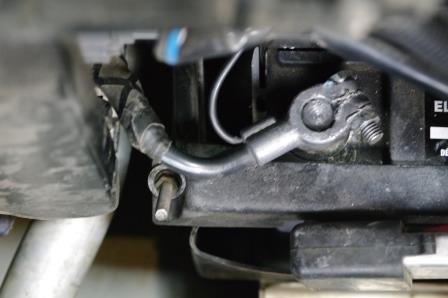I know a number of folks here on Prime have had periodic battery issues resulting in various anomalies (problems starting, strange behaviour from TCS, etc). Many times it turns out that the battery cables and/or connectors turn out bad.
I had some of the similar issues with starting. I followed the advice posted here on Prime by inspecting the cable & their terminations. I removed & replaced the ground strap (with OEM) and was amazed at how both ends of the cable were completely corroded. After replacement, some of the issues were completely resolved.
The positive cable was in pretty bad shape as well and I spent a fair amount of time removing the corrosion & attempting to "reform" the termination for a more snug fit. Now my issue is that some of the electrical gremlins have resolved with the replacement of the negative terminal and few still present (yet improved). The issue still annoying me a bit, is a somewhat slow crank requiring extended crank time for the motor to turn over. Interestingly, if I use one of those battery emergency battery jumper devices and connect it to the jumper terminal in the main fuse box, the car cranks and starts up like any of my other Acuras, super fast. This leads me to believe that the positive terminal/cable is less than ideal.
I've read multiple posts where people recommend merely replacing the end due to the difficulty replacing the positive battery cable. This in itself sounds fine, but I'm afraid that there maybe something else amok with my positive battery cable and am tempted to replace the whole assembly.
I realize the cost of the cable assembly is a bit over the top (as are a number of other components on our beloved NSX), but my real concern is how difficult is the replacement? I searched and can't seem to find any explanation or diagram of the EXACT path of the cable. I know it courses from the front to the rear and from the diagram has multiple grommets on the cable. But does it ever enter the cabin via the firewall or does it merely pass to the rear via the central tunnel all the while remaining remaining outside? If it passes through the tunnel are there other parts to remove to get at the cable, other than the cover (ie. coolant hoses)?
Also, has anyone actually done this procedure? Any tips or cautionary notes?
Thanks.
I had some of the similar issues with starting. I followed the advice posted here on Prime by inspecting the cable & their terminations. I removed & replaced the ground strap (with OEM) and was amazed at how both ends of the cable were completely corroded. After replacement, some of the issues were completely resolved.
The positive cable was in pretty bad shape as well and I spent a fair amount of time removing the corrosion & attempting to "reform" the termination for a more snug fit. Now my issue is that some of the electrical gremlins have resolved with the replacement of the negative terminal and few still present (yet improved). The issue still annoying me a bit, is a somewhat slow crank requiring extended crank time for the motor to turn over. Interestingly, if I use one of those battery emergency battery jumper devices and connect it to the jumper terminal in the main fuse box, the car cranks and starts up like any of my other Acuras, super fast. This leads me to believe that the positive terminal/cable is less than ideal.
I've read multiple posts where people recommend merely replacing the end due to the difficulty replacing the positive battery cable. This in itself sounds fine, but I'm afraid that there maybe something else amok with my positive battery cable and am tempted to replace the whole assembly.
I realize the cost of the cable assembly is a bit over the top (as are a number of other components on our beloved NSX), but my real concern is how difficult is the replacement? I searched and can't seem to find any explanation or diagram of the EXACT path of the cable. I know it courses from the front to the rear and from the diagram has multiple grommets on the cable. But does it ever enter the cabin via the firewall or does it merely pass to the rear via the central tunnel all the while remaining remaining outside? If it passes through the tunnel are there other parts to remove to get at the cable, other than the cover (ie. coolant hoses)?
Also, has anyone actually done this procedure? Any tips or cautionary notes?
Thanks.


































